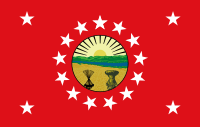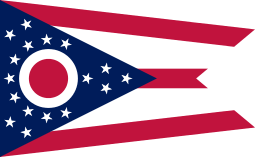James E. Campbell
| James Edwin Campbell | |
|---|---|
 | |
| 38th Governor of Ohio | |
|
In office January 13, 1890 – January 11, 1892 | |
| Lieutenant |
Elbert L. Lampson William V. Marquis |
| Preceded by | Joseph B. Foraker |
| Succeeded by | William McKinley |
| Member of the U.S. House of Representatives from Ohio's 7th district | |
|
In office June 20, 1884 – March 3, 1885 | |
| Preceded by | Henry Lee Morey |
| Succeeded by | George E. Seney |
|
In office March 4, 1887 – March 3, 1889 | |
| Preceded by | George E. Seney |
| Succeeded by | Henry Lee Morey |
| Member of the U.S. House of Representatives from Ohio's 3rd district | |
|
In office March 4, 1885 – March 3, 1887 | |
| Preceded by | Robert Maynard Murray |
| Succeeded by | Elihu S. Williams |
| Personal details | |
| Born |
July 7, 1843 Middletown, Ohio |
| Died |
December 18, 1924 (aged 81) Columbus, Ohio |
| Resting place | Green Lawn Cemetery |
| Political party | Democratic |
| Spouse(s) | Maud Elizabeth Owens |
| Children | four |
| Alma mater | Miami University |
| Religion | Presbyterian |
| Wikimedia Commons has media related to James Edwin Campbell. |
James Edwin Campbell (July 7, 1843 – December 18, 1924) was a Democratic politician from Ohio. He served as the 38th Governor of Ohio.
Campbell was born in Middletown, Ohio where he attended the public schools and then Miami University. He served in the Union Army as a member of the Mississippi River Squadron during the Civil War. He was a master's mate on the gunboats Elk and Naiad until his health gave out and he returned home emaciated.[1]
James Campbell was admitted to the bar in 1865 and began practicing law in Hamilton, Ohio two years later. Campbell was married to Maud Elizabeth Owens of Hamilton, Ohio on January 4, 1870. They had four children.[2] He was a Republican who voted for Lincoln and Grant for President, and after 1872 became a Democrat.[3] After serving as a prosecutor in Butler County, Ohio from 1876–1880, Campbell was elected as a Democrat to the United States House of Representatives twice from Ohio's 7th congressional district (Forty-eighth and Fiftieth Congresses) and once from the third district (Forty-ninth Congress), a seat once held by his uncle Lewis D. Campbell, serving from 1884-1889. In the 49th Congress, he was chairman of the House Committee on Alcoholic Liquor Traffic.
Campbell then was elected to the Ohio governorship, serving from 1890 to 1892. He was an unsuccessful candidate for re-election in 1891, losing to future president William McKinley. During his term as governor, he signed a bill enacting the Australian ballot in Ohio.[4] He called a special session of the General Assembly to remove the corrupt government of the city of Cincinnati. This action cost him the support of Democrats in that part of the state, and prevented his re-election.[5] He was unsuccessful in a third run for governor in 1895.
Campbell was a trustee of the Ohio State University 1895-1896.[6] Remaining politically active, Campbell was a delegate to the Democratic National Conventions in 1892, 1920, and 1924. He served on the commission to codify the State of Ohio laws from 1908-1911. Campbell was nominated for Congress in 1906, but lost, and was his party's choice for Senator in 1908, but was again defeated.[7] In 1913, Campbell was appointed a trustee of the Ohio Archaeological and Historical Society, and he was elected unanimously by the Board of Trustees as president on September 25, 1918. He served as president until his death.[8]
He resumed the practice of law in Columbus, Ohio after 1892 and died there in 1924. He was a Mason, a member of the order of the Elks, the Columbus Club, the Scioto Country Club, the Presbyterian Church, the Grand Army of the Republic, the American Legion, and the Kit Kat Club of Columbus.[9] James Edwin Campbell is interred in Green Lawn Cemetery.
Notes
- ↑ Galbreath 1925 : 14
- ↑ Taylor 1909 : 172
- ↑ Galbreath 1925 : 8, 14
- ↑ Galbreath 1925 : 16
- ↑ Galbreath 1925 : 17
- ↑ Thompson 1923 :470
- ↑ Galbreath 1925 : 18
- ↑ Galbreath 1925 : 3
- ↑ Galbreath 1925 : 20
References
- United States Congress. "James E. Campbell (id: C000087)". Biographical Directory of the United States Congress.
- James E. Campbell at Find a Grave
- Galbreath, C B (1925). "James Edwin Campbell, in memoriam". Ohio Archaeological and Historical Publications. 34: 2–28.
- Thompson, William Oxley (1923). "Tribute to James Edwin Campbell". Ohio Archaeological and Historical Publications. 32: 468–471.
- Taylor, William Alexander (1909). Centennial history of Columbus and Franklin County, Ohio. 2. Chicago: S J Clarke Publishing Company.
| Offices and distinctions | |||||||||||||||||||||||||||
|---|---|---|---|---|---|---|---|---|---|---|---|---|---|---|---|---|---|---|---|---|---|---|---|---|---|---|---|
| |||||||||||||||||||||||||||


